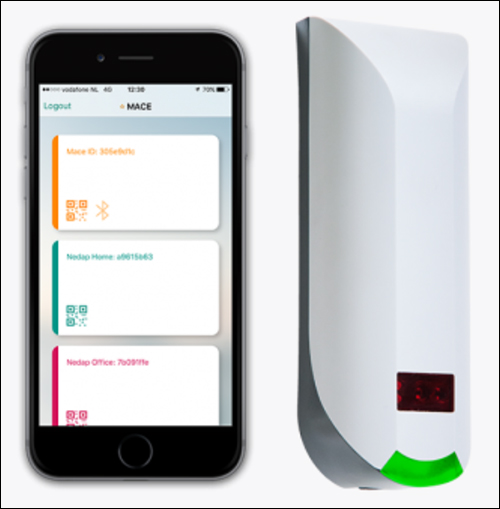Nedap Identification Systems has upgraded its Mobile Access Control Enabler (MACE) access-control solution with a software developers kit (SDK) and a portal to enable companies to integrate wireless access leveraging smartphones into a company’s existing system, and with a company’s own app. With the MACE App SDK, businesses can integrate Nedap’s MACE app functionalities into their own application so that users can interact directly with the companies’ own app.
The system now comes with MACE REST API, which serves as an exchange command between the MACE administrators’ portal and the company’s own access-control system. The system also comes with improved Bluetooth Low Energy (BLE) performance and added security features, according to Nora Roebers, Nedap’s product manager.
The MACE solution was launched in May 2016 as a way to enable companies to provide individuals with access to a facility without requiring that they acquire or turn in a physical access card or key. Instead, they can simply use their phones. The system consists of Nedap’s MACE reader (see Nedap Intro’s Slim Mobile-access Reader), which serves as a BLE beacon, a Near Field Communication (NFC) 3.56 MHz reader and a QR code scanner, as well as the MACE app and software to verify the unique identifier on an individual’s phone in order to confirm that he or she can enter the premises.
In recent years, access-control systems have been evolving beyond physical access cards, the company has found. “We have seen a shift toward new solutions to enable users to identify themselves,” Roebers says. Although many companies are still using ID badges, the ease of a mobile phone-based credential is providing firms with a way to quickly provide or revoke access for employees, contractors or visitors. “We don’t think physical cards will disappear either,” he states. For that reason, the readers and solution are designed to accommodate traditional ID cards as well, using both smart-card and proximity-card technologies, or with QR codes.
When a company chooses to provide an individual with access to a building or secured area, it can send a notice to that person, along with a verification code. He or she can download an app and create a MACE account, or use the company’s own app, then input a verification code on his or her phone.
The system can be set up for users to choose from BLE, NFC or QR code technology, based on their preferences or their smartphone’s functionality (for example, iOS-based phones cannot currently be used for NFC reads beyond Apple Pay functionality). Upon arriving at a site, such as at a building entrance, an individual presents his or her phone to the MACE reader. Users can configure the reader for specific read ranges (in the case of BLE) that best suit a particular use case. They can also require specific actions by a phone user, prior to triggering a BLE transmission, thereby preventing stray reads.
The reader comes with a variety of output options, including Wiegand and the Open Supervised Device Protocol, (OSDP) to forward data directly from the reader to a company’s existing access-control system. Businesses using the technology have asked to remain unnamed, though Roebers describes them as falling into three general categories: businesses such as office complexes, as well as parking companies and residential buildings.
In the case of an office or some other business complex, the readers are typically installed at entrances, as well as in secure areas within the facility (such as at elevators) on certain floors or wings, where access is provided only to those who provide specific credentials. A user taps his or her phone near the reader to be recognized. The MACE software then confirms that person’s credentials, and the collected data is forwarded to the company’s access-control system, which opens the door or gate lock, permitting access.
If designed to do so, the system can also store data for historic records or analytics purposes. If a user is no longer an active employee or an authorized contractor, the firm can simply revoke his or her credentials from the MACE system, and that individual will no longer be admitted.

Parking companies can use the system similarly, to provide customers with necessary credentials once they have paid for a space or if they are authorized employees or other approved individuals. A mobile phone could then be used at the gate as the individual drives into the lot.
Finally, in residential applications, a resident could use his or her apartment building’s app to gain credentials to access the building and apartment. The app can also issue virtual credentials to visitors, in order to provide them with temporary access to the building. The credential ID numbers can be reused in a secure way, Roebers says, once they are revoked.
With the latest version of MACE, companies can use the SDK to build the system into their own app and then modify it according to their needs. This could include deciding on BLE or NFC only, or QR codes only, as well as offering prompts that can be selected. Rules can also be established, such as requiring a user to shake or manipulate the phone in a specific way to launch a BLE read.
“Customers have the freedom to choose what function they want to enable BLE,” Roebers states. The latest updates are part of a continual process of upgrades for the solution, she explains. “We have a platform that is continuously under development, since the technique is evolving and phones have constant upgrades.” According to Roebers, several access-control technology partner companies are currently installing the solution.


